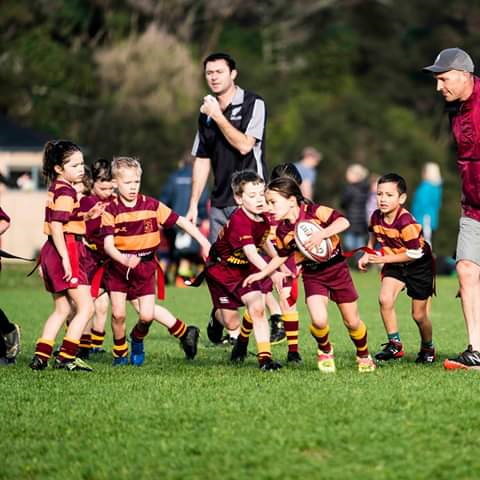
J7-8
J7-J8 Laws
Rippa Rugby is the non-contact version of rugby. It is designed to introduce new players to the game without fear of contact so they can learn the fundamental rugby skills of catching, passing, running, and scoring tries.
- Categoryrules
- Last UpdatedSep 2021
Laws
- Field:
- Each game is played between the try line and the 10m line (they form the sidelines) but can be reduced or expanded to cater to the number of players involved.
- Time:
- 20 minutes each way with a 2-minute break at halftime. (Maximums)
- Ball:
- Size 2 ½ or 3
- Players:
- Teams comprise seven players.
For normal Saturday games, it is expected that all players should play as much as possible, therefore team numbers can be manipulated at the agreement of both coaches. - Subs:
- All players must play half a game which may consist of one half or two quarters i.e. Substitutions may be made at quarter-time, half-time or three-quarter-time. No rolling substitutions are permitted.
- Coaches:
- Coaches are allowed on the field of play to help players in general and positional play.
- Tackle (Rip)
- To complete a 'rip' one of the two flags from the ball carriers’ belt must be removed.
- Only the ball carrier can be ripped.
- The ripper stops holds the flag above their head and shouts "RIP!”
- The ball carrier must then pass the ball within three steps. He or she does not have to stop, return to the mark, or tap the ball before passing
- After the ball carrier has passed the ball the ripper must hand the flag back to the player who then reattaches it to their belt before they rejoin play.
- Six rips in a row leads to a turnover in possession.
- The belt must be worn outside the clothing and flags positioned one on each hip.
- If a player is 'ripped' when crossing the try line, they restart play five metres out from the try line.
- Offside:
- Offside only occurs at the rip.
- When a rip is made, all players from the ripper's team must get back until they are in front of where ball is being passed from (facing the opposition).
- If a player is offside and they intercept, prevent, or slow down a pass, a free pass will be awarded to the non-offending team.
- A free pass is used to:
- Start play.
- Restart after a try is scored (non-scoring team).
- Restart after a turnover or a penalty offence.
- To make a free pass, the referee calls "Play" and the player passes the ball backwards to a member of their own team.
The opposition team must remain five metres back from the free pass.
- Penalties:
- Kicking
- Contact of any kind (pushing, tackling, fending).
- Hiding or shielding Rippa tags.
- Offside
- Diving on the ball on the ground.
- Not handing back Rippa tag.
- Continuing to run after rip (more than 3 steps).
- Turnover of Possession :
- Knock On
- Forward Pass.
- Ball or ball carrier outside the field of play.
“Everyone Enjoying Rugby”
North Harbour Rugby
Advice & Guidance
J8 and J7 Rippa rugby is currently organised by the clubs themselves. Northcote organises a competition with Marist, Takapuna and Glenfield and each week all teams will play at one of the clubs.
That being the case the rules and setup are not always done the same as clubs outside of the group for example North Shore may run things differently.
It has also meant that some rules and conventions differ from what Harbour stipulate. The best thing you can do is talk with teh opposition team and ensure everyone is agreed on how the game will be played.
Playing Numbers & Subsitutions
A very common change is that most teams allow substitutions throughout the game. These are allowed at any stoppage of play, (try, scrum, lineout). One opinion is that this works better allowing kids to have breaks and avoid boredom sitting on the sideline as they are 5-7 year-olds with short attention spans.
Another thought is not to put more than seven players on the field as this becomes more chaotic to manage and kids get lost with some spending a lot of time on the field and never touching the ball or making a rip and this isn't seen as productive participation.
Rips
It is not that simple for two 6-year-olds, who don't know each other to coordinate the handing back of the rip during the middle of a game with lots of noise and chaotic stuff. Consider encouraging the standing still and holding high and trying to hand the rip back but only penalise when they throw the rip away.
Offsides
This can be quite common but a good one to warn and enforce. The sooner players understand this concept the sooner the game becomes less chaotic and easy to control.
Remember, they are 6 years old so work out where that balance is between a flowing game and a fair game.
Coaches on the field
The coach is on the field to help organise and control their team. Hopefully to also help each player have a run with the ball. They are not there to coach moves or plays and they are not there to help you referee.

